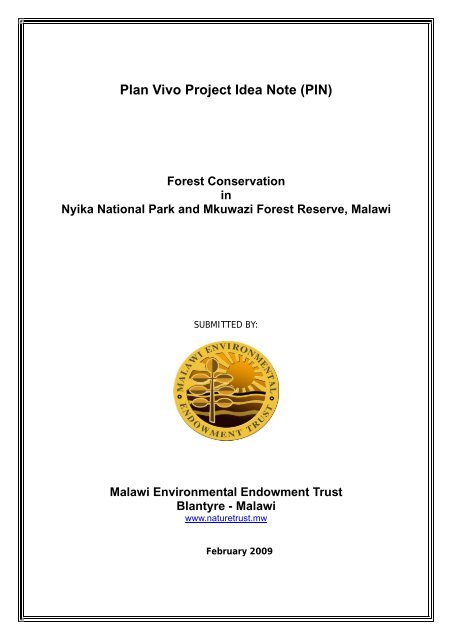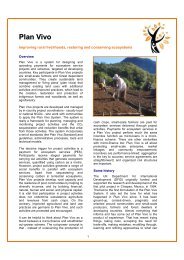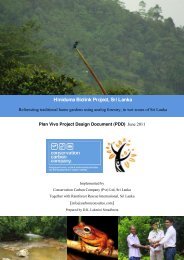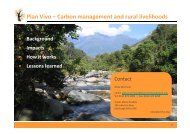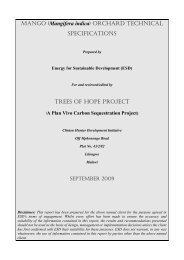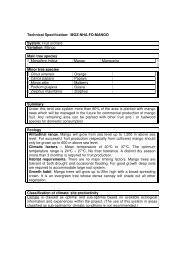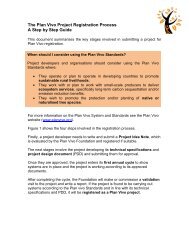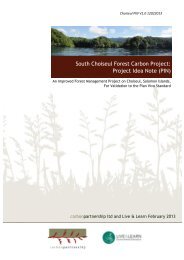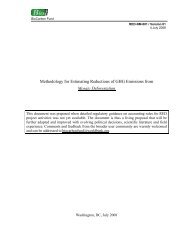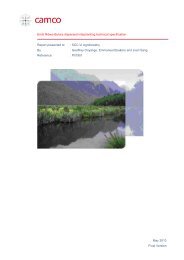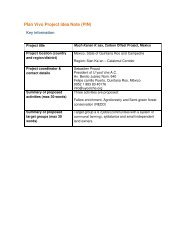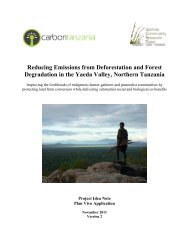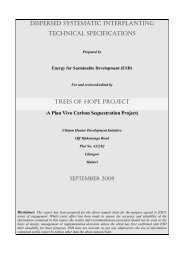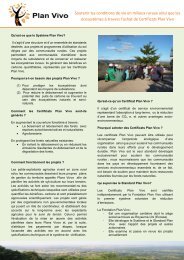Plan Vivo Project Idea Note (PIN)
Plan Vivo Project Idea Note (PIN)
Plan Vivo Project Idea Note (PIN)
You also want an ePaper? Increase the reach of your titles
YUMPU automatically turns print PDFs into web optimized ePapers that Google loves.
Table of Contents1. SUMMARY OF PROJECT OBJECTIVES, PROPOSED PROJECT ACTIVITIES AND IMPACTS 11.2 Proposed <strong>Project</strong> Activities..................................................................................12. TARGET GROUPS/COMMUNITIES................................................................... 43. PROPOSED PROJECT AREA ........................................................................... 53.1 Physical Environment...............................................................................................53.2 Climatic Conditions ..................................................................................................63.3 Land Use and Land Cover .......................................................................................63.4 Socio-Economic Environment ..................................................................................83.5 Local Governance Structure ....................................................................................94. OWNERSHIP OF CARBON RIGHTS .................................................................. 95. PROPOSED GOVERNANCE STRUCTURE OF ORGANISATIONS INVOLVED................. 105.1 The Priority Grant Activities That the Organization is Supporting: .............................106. COMMUNITY-LED DESIGN PLAN.................................................................. 117. ADDITIONALITY ANALYSIS ......................................................................... 118. COMPLIANCE WITH RELEVANT NATIONAL AND INTERNATIONAL REGULATIONS ..... 129. SOURCES OF START-UP FUNDING................................................................ 12ANNEXES ...................................................................................................... 14ANNEX 1 MINUTES OF PLAN VIVO TRAINING .................................................... 15ANNEX 2 LIST OF MEMBERS PRESENT DURING PLAN VIVO TRAINING .................... 23<strong>Plan</strong> <strong>Vivo</strong> <strong>PIN</strong>i
TablesTable 1:Table 2:Table 3:Table 4:Table 5:Table 6:Summary of activities to be carried out by communities aroundMkuwazi Forest reserveEstimated areas covered by each of the land use and land cover classespresent within Mkuwazi Forest Reserve and the Thazima region of NyikaNational Park.Changes in land cover over recent years (adapted from Nkwanda et al.2008)Changes in forest cover over recent years (Adapted from Nkhwanda etal 2008)Socio Economic IndicatorsBarriers for proposed projectFigureFigure 1:Locations and boundaries of a) Nyika National Park, and b) MkuwaziForest Reserve within Malawi.<strong>Plan</strong> <strong>Vivo</strong> <strong>PIN</strong>ii
1. SUMMARY OF PROJECT OBJECTIVES, PROPOSED PROJECT ACTIVITIESAND IMPACTSThe proposed project is for the conservation of forest within Mkuwazi Forest Reserveand Nyika National Park in the Northern part of Malawi. The project has the followingobjectives:• To ensure continuous forest cover for carbon conservation, maintenance ofbiodiversity, protection of watersheds, and prevention of soil erosion.• To ensure increased and continued supply of forest products• To provide alternative income generating activities for improved livelihoods, and• To provide improved energy saving stoves so as to decrease the pressure on theforest reserves for provision of firewood.The forest within these areas is at risk of deforestation degradation in the futurethrough encroachment and overexploitation. The forests are regarded as a freeresource by communities surrounding them making them more susceptible toexploitation. Forest conservation will reverse the trend of degradation, preservebiodiversity, maintain important watersheds, and provide opportunities for livelihooddevelopment through sustainable exploitation of forest products by localcommunities.1.2 Proposed <strong>Project</strong> ActivitiesPotential project activities identified by communities in the vicinity of Mkuwazi forestreserve are described in Table 1. These activities are specifically for Mkuwazi ForestReserve, which were identified during a one day training meeting that wasconducted. Participatory Rural Appraisal was conducted to identify these activitiesand the same will be done in Nyika National Park at a later date to identify specificactivities for that area. However, taking into consideration the similarity of set up ofthe communities surrounding these protected areas, the activities that wereidentified at Mkuwazi are likely to be similar or the same as those for communitiessurrounding Nyika National Park given that they follow the same communityorganizational framework, methodology, and approach introduced and implementedby COMPASS II/USAID.<strong>Plan</strong> <strong>Vivo</strong> <strong>PIN</strong> 1
Table 1: Summary of activities to be carried out by communities around Mkuwazi Forest reserveProposedproject activityBeekeepingWoodlotsFish FarmingInputrequirements• Beehives• Bee suits• Smokers• Leather Gloves• Gum boots• Catcher Boxes• Honey SievingCloth• Brushes• Pails• Various nurseryequipment• Polythene tubes• Tree seeds• Fish pondconstructionmaterials.• Fingerlings• Fishing netsTechnical supportrequired• Training inbeekeepingprinciples• Building capacityin businessplanning skills• Training innurseryestablishmentandafforestation• Training in fishfarming andharvestingSkills/experienceavailable locally• Some members of thecommunities weretrained in beekeeping• Further, there areapproximately 152Malawi Gold Standard(MGS) service providers,who are trainers oftrainees specializing inbeekeeping. These MGSservice providers can becalled upon for a fee toprovide training locally.• Some members of thecommunities have beentrained in afforestationby the ForestDepartment• The communities havelocal knowledge offishing as the area isalong the lakeshore.• They can also purchaseAnticipated impacts on livelihoods andlocal economic sustainability,biodiversity, and watersheds• Beekeeping as an income generating activitywill help in improving the livelihoods ofthe communities.• Beekeeping will help in forest conservationas the hives will be hung in the forest.• Woodlots establishment and planting oftrees will help to reduce pressure on theforest and help in its conservation.• Woodlots establishment will help in thecatchment conservation resulting intowatershed management and biodiversityconservation.• Fish farming as an alternative incomegenerating activity will help in improvingthe livelihoods of the communities.<strong>Plan</strong> <strong>Vivo</strong> <strong>PIN</strong> 2
twinethe MGS forAquaculture Productionproduced by COMPASSII. The handbookprovides detailedguidance on becoming apond-based fish farmer.Ecotourism/TourGuide• Maps• Boots• Training in TourGuide principles• Some members of thecommunities are alreadyguiding tourists into theForest reserve usinglocal knowledge.Recently, COMPASS IIsupported training of 8tour guides, who will belinked to area lodges andhotels.• Escorting Tourists in the Forest Reserve asone way of income generation will help inimproving the livelihoods of thecommunities.Introduction andpromotion ofimproved (or fuelefficient) CookStove• Material formakingimproved stoves• Training inmaking and useof improvedcook stoves• The communities haveknowledge of other cookstoves that they use inthe area even thoughthey are not really energysaving stoves• Improved cook stoves will help in theconservation of the forest as the pressurefor firewood collection will decreaseresulting in the conservation of biodiversityand watershedsSustainable harvestof non timberproducts, timberand firewood• Co-managementplan forutilisation of theForest reserve• Awarenesstraining for theuse of the forest• Communities currentlyregard the forest as thesource of free resourcesresulting intoexploitation of theforestry• Sustainable utilisation of the forest reservewill assist in the conservation andmanagement of the forest reserve and helpmaintain biodiversity.<strong>Plan</strong> <strong>Vivo</strong> <strong>PIN</strong> 3
especially since the Block Management Committee will also have the local area chiefrepresenting the community members, who are not members of the manyenterprises/clubs. In addition to the members from the communities itself, the BlockManagement Committee will also include a member representing the Department ofForest, at the District level.3. PROPOSED PROJECT AREA3.1 Physical EnvironmentThe locations of Mkuwazi Forest Reserve and Nyika National Park are shown in Figure1. Nyika National Park (10°33’S, 33°50’E) is located within the Chitipa, Karonga, andRumphi districts, and Mukwazi Forest Reserve (11 o 72'S, 34 o 05'E) is in the NkhataBay district of Malawi . The boundaries of Mkuwazi Forest Reserve and Nyika NationalPark represent the areas within which project activities will be carried out, and fromwhich carbon benefits will be calculated.Figure 1. Locations and boundaries of a) Nyika National Park, and b)Mkuwazi Forest Reserve within Malawi.<strong>Plan</strong> <strong>Vivo</strong> <strong>PIN</strong> 5
3.2 Climatic ConditionsThe climate of Nyika National Park is distinct from that of the surrounding regionbecause of its high elevation and associated cloud cover. Rainfall is not unusuallyhigh for Malawi, between 900 and 1500 mm per year in Thazima, but the lowertemperatures at high elevations result in low rates of evaporation. Over 90% of thetotal annual rains fall from November to April and frosts occasionally occurthroughout the park during the winter months (DNPW 2004).Mkuwazi Forest Reserve, on the other hand, is characterised by high annual rainfallof around 2,200 mm and high temperatures, which create an environment suitablefor the development of large broad leaved trees.3.3 Land Use and Land CoverThe total land area of Malawi is 94,080 km 2 , around 26% of which is covered byforest 1 (Department of Forestry 2004). Around 6,920 km 2 of Malawi is protectedincluding 5 National Parks and 88 Forest Reserves (World Resources Institute 2003;Figure 1).Nyika National Park was gazetted in 1965 and expanded to a total area of 3,134 km 2in 1978, at which time communities within park boundaries were resettled outsidethe park. Land cover within the park consists of Miombo woodland dominated byJulbernardia globiflora, Brachystegia. bomeii, B. bussei, B. speciformis, Isoberlinaanglensis, and Monotes africanis; grassland dominated by Loudetia simplex,Andropogon schirensis, and Pleridium acquilium; savannah; and evergreen forest(DNPW 2004).Mkuwazi Forest Reserve was gazetted in 1927 and covers a total area of 17.7 km 2 .The area is dominated by Brachystegia speciformis and B. longifolia on the lowerdryer slopes and evergreen forest comprised of Afrosersalisia cerasifera,Erythrophloem saueolens, Pterocareous stolzii and Chlorophora excelsa along riversand in damper areas (Chapman and White 1970).Customary land surrounding Nyika National Park and Mkuwazi Forest Reserve isprimarily exploited by smallholder farmers. The main crops cultivated are maize,beans, and ground nuts, with some commercial farmers on estate land producingtobacco. On the wetter slopes to the east of Nyika National Park coffee is also grown.Mkuwazi Forest Reserve is bordered to the north by the Vizara rubber plantation.Estimated land cover within the project areas is described in Table 1.1 Forest land is all land spanning more than 0.5 hectares with trees higher than 5 meters and a canopy coverof more than 10 percent<strong>Plan</strong> <strong>Vivo</strong> <strong>PIN</strong> 6
Table 2: Estimated areas covered by each of the land use andland cover classes present within Mkuwazi Forest Reserve and theThazima region of Nyika National ParkMkuwaziArea (ha)Evergreen forest 600 34.0Miombo woodland 620 35.1Shrubs and scatteredtrees300 17.0Open grassland 100 5.7Cultivated land 147 8.3Total 1,767 100.0Nyika National ParkEvergreen forest 1.796 5.0Miombo woodland 12,569 35.0Savannah 718 2.0Open grassland 20,828 58.0Total 35,910 100.0Percentage land cover(%)Source: Berry, N. et al. “Estimating Carbon Stocks: Toward Forest Conservation in NationalParks and Forest Reserves in Malawi.” November 2008, COMPASS II Technical Report,COMPASS II/USAID. Malawi.In 1975, 57% of Malawi was classified as forest, but by 2000 this had been reducedto 28% (Nkwanda et al. 2008). Data from the FAO (2007) suggest that between1990 and 2005 around 38,000 hectares of forest land was lost per year, which isequivalent to an annual loss of 0.9% of forest (see Table 4), and recent estimatessuggest a rate of deforestation of 1.6% per year between 1991 and 2008 (Owen etal. 2008). While other sources suggest higher rates of 2.8% forest loss per year,rates of up to 3.4 % per year have been recorded in the northern regions of Malawiwhere rates of deforestation are highest (EAD 2001).Table 3: Changes in land cover over recent years (adapted from Nkwanda et al. 2008)Area (‘000Ha)Land cover 1990 2000 2005Forest 3,896 3,567 3,402Other Land 5,512 5,841 6,006Total 9,408 9,408 9,408Source: FAO (2005; 2007)<strong>Plan</strong> <strong>Vivo</strong> <strong>PIN</strong> 7
The losses of forest have been particularly severe in primary forest land, whichincludes areas within National Parks and Forest Reserves. Between 1990 and 2005there was a loss of 595,000 ha of primary forest, which is equivalent to a loss of2.3% of original primary forest cover per year, while the areas of disturbed forest andplantations increased (see Table 5).Table 4:Changes in Forest Cover Over Recent Years (Adapted fromNkhwanda et al 2008)Area (‘000ha)Land Cover 1990 2000 2005Primary Forests 1,727 1,330 1,132Disturbed forest 2,037 2,057 2,067<strong>Plan</strong>tations 132 180 204Total 3,896 3,567 3,402Source: FAO (2005)3.4 Socio-Economic EnvironmentMkuwazi Forest is in Nkhatabay district is one of the five districts in the Northernregion of Malawi. The Forest reserve is surrounded by eight Group Village Headmengoverning 7 villages, which are Khwerenje, Phetera, Matwewo, Ching’anya,Chakuluma, Simon, and Ndiwere. Group Village Headman is a local governingstructure that is put in place in Malawi whereby a number of villages form up onegroup village headman. The elected group Village Headman will be responsible for allthe matters relating to all surbodinates villages.The population of the entireNkhatabay District is estimated at 202,388 with an area of 4000 square kilometers.The population growth rate is estimated to be 2.7. (Nkhatabay District Assembly DEP2008- 2011)Table 5: Socio Economic IndicatorsPopulation 202,388Density 50.57Growth rate 2.7%Literacy Level 65%Life expectancy 45HIV/AIDS Prevalence Rate 17%Source: Nkhatabay District Assembly DEP 2008- 2011The district tribes constitute 64% Tongas and 33% Tumbukas in the mountainouslakeshore north. The other tribes, mostly immigrants, constitute the remaining 3%.Source of livelihood is very varied. Cassava forms the main staple food.<strong>Plan</strong> <strong>Vivo</strong> <strong>PIN</strong> 8
management and resource-use agreements with local communities that make use ofthese resources.In Nyika National Park the DNPW has established co-management agreements withcommunities on the periphery of the park, through the already mentioned ResourceUse Agreements, which allow the collection of forest products including honey, fruits,thatch grass, mushrooms, medicinal plants, termites, caterpillars, and dead wood forfuel, within 5 km of the park boundaries.Communities surrounding Mkuwazi Forest Reserve have entered into a comanagementagreement with the Department of Forestry to promote participatorymanagement of the Forest Reserve through protection, control and sustainableutilisation of forest resources. Through the Co – management plan, the communitieswill have rights to benefit from the forest and giving them the right to the carbonwithin the forest reserve. Village Natural Resource Management Committees(VNRMC) take responsibility for the maintenance and management of forestresources within a defined area and in return are entitled to a share of the benefitsthat arise from co-management.5. PROPOSED GOVERNANCE STRUCTURE OF ORGANISATIONS INVOLVEDThe project will be coordinated by the Malawi Environmental Endowment Trust(MEET). MEET is a non-profit, independent organisation registered in March 1999under the Trustees Incorporation act of 1962 of the laws of the Government ofMalawi. The Trust was established as a sustainable funding mechanism in responseto the realisation that late and often inadequate availability of funds were among themajor obstacles to addressing environmental degradation in the country. Through themanagement of a grant facility, the Trust supports specific priority activitiesdeveloped in cooperation with the country's development partners and other fundinginstitutions.A Board of Trustees responsible for Trust’s vision and fiduciary management is inplace which oversees the Board of Governors. The Board of Governors representingvarious stakeholders is in place for policy and procedural matters within the mandateof its Constitution and all applicable by laws and standing policies of Malawi. TheManagement team is responsible for day to day running of the activities which iscomprised of various personnel of various backgrounds at professional levels.5.1 The Priority Grant Activities That the Organization is Supporting:Include:• AfforestationInformation• Soil and Water Conservation• Research• Natural Resource Based Enterprise• Waste management• Renewable Energy• Wildlife Management and• Environmental Education andConservation<strong>Plan</strong> <strong>Vivo</strong> <strong>PIN</strong> 10
To date, the organization has supported close to 160 projects through out thecountry to the tune of USD1.9 million and consequently improving the livelihoods ofthe once affected communities.MEET will engage Technical Partners from Chancellor College, the LEAD Team, andexperts from the Forestry Research Institute of Malawi (FRIM) for all the Technicalaspects of the project such as developments of the technical specifications andmonitoring of the project. Members from these institutions were already trained intheir respective roles.6. COMMUNITY-LED DESIGN PLANThe project was designed following the meeting that MEET had with the communitiesaround Mkuwazi Forest reserve. Present during the meeting were officials fromForestry Department, officials from MEET, an official from <strong>Plan</strong> <strong>Vivo</strong> and an officialfrom Ecotrust in Uganda. Overall support for this meeting was provided by COMPASSII/USAID.The communities were taken through <strong>Plan</strong> <strong>Vivo</strong> training with a view of making themunderstand Climate Change and its consequences. The training was conducted by arepresentative of <strong>Plan</strong> <strong>Vivo</strong> Foundation, with assistance from a representative fromEcotrust, based in Uganda. MEET’s role in this activity was to facilitate theidentification of causes of deforestation in the Forest Reserve and the alternativesthat can be put in place to prevent further degradation of the Forest Reserve.From the meeting, it was observed that to date, there are four main groups or clubsthat are active in benefiting, economically, from the Mkuwazi Forest reserve. Thesefour community clubs are Ecotourism group, Beekeeping Group, Woodlot group andForest Patrol group. These groups were left with an assignment to discuss withintheir groups the actions that were to be carried, all the resources required for theidentified activities to be implemented and benefit sharing mechanisms.Attached on Annex I are the minutes from the community meeting that was held andthe list of the participants that were present.7. ADDITIONALITY ANALYSISMalawi recognises the importance and urgency of addressing the problemsassociated with Climate Change because these affect the sustainable livelihoods of allMalawians. Hence the need to urgently implement the proposed adaptation optionslisted in the National Adaptation <strong>Plan</strong> of Actions document. However, there areseveral barriers that may hamper the implementation of these activities. There is aneed to address these for the smooth implementation of the proposed activities.<strong>Plan</strong> <strong>Vivo</strong> <strong>PIN</strong> 11
The barriers of the proposed project at Mkuwazi Forest Reserve and ways ofovercoming them have been summarized in Table 6 below:Table 6: Barriers for Proposed <strong>Project</strong>BarrierLack of financial resource forconservation activitiesLack of awarenessActionPayment for ecosystems will help inreducing the problemEnvironmental Education and provisionof Environmental Education materialsLack of alternative income sources Introduction of alternative incomegenerating activities such as beekeeping,Fish farming and Mushroom productionLack of energy saving stoves Introduction of energy saving cookstovesLack of regulation on Forestry useImproved enforcement through the Comanagement<strong>Plan</strong>8. COMPLIANCE WITH RELEVANT NATIONAL AND INTERNATIONAL REGULATIONSAND NOTIFICATION OF RELEVANT BODIESAfter the Earth Summit in Rio de Janeiro, Brazil in 1992, Malawi launched its NationalEnvironmental Action <strong>Plan</strong> (NEAP) in 1994 (EAD, 1994; 1995). NEAP, which isMalawi’s operational tool for the implementation of the Agenda 21, was developedthrough a consultative process involving a wide cross-section of stakeholders atnational and local levels. This NEAP identifies and highlights several environmentalissues including: high soil erosion, low fertility, deforestation, overgrazing, overfishing, loss of biodiversity, water resources degradation and depletion, humanhabitat degradation, air pollution and climate change.Currently, Malawi has developed policies and strategies to stimulate economic growthand development. This will be done through reducing poverty to ensure food andwater security, empowering vulnerable rural communities, ensuring sustainableutilization of Malawi’s abundant natural resources, and by protecting theenvironment, as articulated in Malawi Growth and Development Strategy (MGDS) andthe National Environmental Action <strong>Plan</strong> (NEAP)The proposed project is within the MGDS and will help in adaptation to climatechange in the country.9. SOURCES OF START-UP FUNDINGThe physical study of the proposed areas was done with funding from COMPASSII/USAID, a project funded through USAID. The funding as well as technical andadministrative leadership from COMPASS II also helped drive the development ofassessing carbon credits with a focus on REDD. Further, COMPASS II/USAID alsofinancially supported the development of the Technical specification and training ofthe technical personnel, who are now equipped to monitor the project.<strong>Plan</strong> <strong>Vivo</strong> <strong>PIN</strong> 12
COMPASS II also funded hiring of the consultants from <strong>Plan</strong> <strong>Vivo</strong> and Ecotrust, whoconducted some trainings to the communities and MEET officials. As the designatedproject coordinator for <strong>Plan</strong> <strong>Vivo</strong> <strong>Project</strong>s in Malawi, MEET contributed to thelogistical arrangements of the consultants to the field for community trainings andwill continue supporting the activities regarding the development of the <strong>Project</strong>Design Document and all other subsequent activities regarding the project up until itis registered by <strong>Plan</strong> <strong>Vivo</strong> since COMPASS II comes to a close in May 2009.<strong>Plan</strong> <strong>Vivo</strong> <strong>PIN</strong> 13
ANNEXES<strong>Plan</strong> <strong>Vivo</strong> <strong>PIN</strong> 14
ANNEX 1MINUTES OF PLAN VIVO TRAININGMINUTES OF THE PLAN VIVO TRAINING HELD ON 11 THFEBRUARY 2009 AT CHINTHECHE – MKUWAZI COMMUNITY INNKHATA-BAY DISTRICTPRESENTMEET STAFF MEMBERS1. Benson Chipezaani2. Patson Nthala3. Rodrick Kamoto4. Roselyn Chavunya5. Margaret NamadzundaGOVERNMENT PERSONNEL FROM FOREST DEPARTMENT1. G. Simlemba2. J. MkhutaMEMBER ECO-TRUST FROM UGANDA1. Gerald KairuMEMBER PLAN VIVO FOUNDATION FROM SCOTLAND1. Alexa MorrisonSIXTY EIGHT (68) COMMUNITY MEMBERS AS PER THE ATTACHED LIST.1.0 OPENING REMARKS1.1 The meeting started with a word of prayer by one community member, followedby welcoming remarks by the Head teacher of the primary school where the meetingwas held,l who thanked the visitors form Scotland, Uganda and MEET for theirinterest to visit them.1.2 After the opening remarks it was followed by the introductions by all theparticipants. Sixty eight (68) community members attended the training. Theparticipants included the Mkuwazi Association members, beekeeping club membersand Mkuwazi tour guides.<strong>Plan</strong> <strong>Vivo</strong> <strong>PIN</strong> 15
1.3 MEET REMARKS – OBJECTIVE OF THE TRAININGThe Operations Director of MEET Mr. Benson Chipezaani thanked thevillage headmen and all the community members for their availability tothe training even though it was at a short notice. He mentioned that theaim of the training was to encourage the communities around MkuwaziForest Reserve to take care of the forest, and to train them how they canimplement the <strong>Plan</strong> vivo program with the Assistant from the PLAN VIVOexperts from Scotland.1.4 REMARKS BY THE FACILITATOR ALEXAShe mentioned that the training was a continuation of the program whichstarted last year in September 2008. She mentioned that since COMPASS IIis phasing out, MEET will takeover from where COMPASS stopped and theyare the ones to be working hand in hand with the Mkuwazi community.PRESENTATIONS BY FACILITATORS(a)GERALD’S PRESENTATIONHe mentioned that he was very encouraged with the combination of theparticipants as it comprises of all groups who are involved in the activitiesof Mkuwazi Forest Reserve. He encouraged the communities to take careof the forest; because once it is spoiled it will result into climate change.Climate change means; changing of seasons and weather conditions like,rainy, summer, winter.(i)CLIMATE CHANGE RELATIONSHIP WITH FOREST• What causes climate change?1. Cutting down of trees carelessly for timber, poles etc.2. Not replanting trees3. Over grazing from overstocking of animals4. Charcoal burning5. Opening gardens for agriculture6. Shifting cultivation• How does cutting down of trees cause climate change?1. Cutting down of trees can make rains not come.• What is the food for the trees?o Watero Soilo Air (Carbon dioxide)<strong>Plan</strong> <strong>Vivo</strong> <strong>PIN</strong> 16
The carbon dioxide which the trees use is the same gas that people breathe out andthe trees give out oxygen which people can breathe in.When people cut down trees this means that the carbon dioxide that we produce willnot be absorbed by the trees, and as a result it will contribute to climate change i.e.too much rains or no rains at all.(ii)OTHER CAUSES OF CLIMATE CHANGE1. Estate or Factories i.e. Dwangwa Sugar Estate (Industry)When sugar is being manufactured, smoke which is released in the cause ofproduction, this smoke contains carbon dioxide which goes into theatmosphere, as a result it causes climate change.2. CarsWhen people drive the cars the cars produce carbon dioxide which alsogoes into the atmosphere and causes climate change.These activities increase carbon dioxide in the atmosphere, and as a resultthe carbon dioxide forms a thick layer which acts like a blanket causing theclimate to change, i.e. this can mean higher temperatures, too much rain,storms, no rains at all, etc.The conclusion to this presentation was that if we cut down trees, therewill be too much carbon dioxide in the atmosphere, and if we plant moretrees we can absorb carbon dioxide and reduce climate change. For this totake place the community was encouraged to work together to avoidclimate change by planting more trees and taking care of them.In his remarks Gerald thanked all participants for their listening andparticipation, he also thanked the translator (the head teacher of theschool for his good translation).(b)ALEXA’S PRESENTATIONShe mentioned that <strong>Plan</strong> <strong>Vivo</strong> is a living system which encourages thecommunity to plant more trees. She mentioned that at the moment <strong>Plan</strong><strong>Vivo</strong> is being implemented in the following countries; Uganda, Mozambiqueand Mexico and now Malawi have been proposed to start implementing thisprogram.<strong>Plan</strong> <strong>Vivo</strong> <strong>PIN</strong> 17
(i)What can we do to avoid Climate Change?o Avoid cutting down of treeso <strong>Plan</strong>t more treeso Maintain the existing forestsIn UK we deforested our land many years ago, have many cars, as well as so manyfactories, and these are causing climate change. Countries like the UK need toreduce the activities they do that produce carbon dioxide, but have also decided theyhave a responsibility to help countries like Malawi, Uganda, and Mozambique to helpreduce deforestation. This resulted in trade of carbon dioxide and is called theCarbon Market. She mentioned that this market is very different from all othermarkets because you can’t necessarily see or hold the thing you are buying, and it isnot the trees or the land that are being bought; however it is necessary for the buyerto be assured of the existing carbon by monitoring the piece of land where the treesare being conserved.For this market to be in place there is a need to have proper agreements betweenthe community and the buyer. Only the trees that are being taken care of are eligiblefor this market. The carbon will be purchased directly through MEET.The community will be working hand in hand with MEET and see to it that theMkuwazi Forest Reserve is being taken care of for the carbon market to be a success.(ii)STEPS FOR PLAN VIVO1. The communities of Mkuwazi need to be trained for them to know howplan vivo will assist them and how it will work.2. The communities need to put up a plan which will later be approved byMEET.3. The communities need to know how much carbon they will be protectedfrom the forest reserve, which is calculated by looking at the weight of thetrees, MEET will do this calculation. Roughly half of a tree is water, and halfis dry wood. Half of dry wood is pure carbon. Out of this the communitythrough MEET can know how much carbon is in Mkuwazi forest.4. Monitoring and Payments. The money for the carbon will be paid afterproper monitoring of the forest reserve. MEET is the one to monitor theforest and give a report to <strong>Plan</strong> <strong>Vivo</strong>. The money will be paid in stages.The community will sign a contract with MEET. The contracts could be forup to 10 years or 15 years.<strong>Plan</strong> <strong>Vivo</strong> <strong>PIN</strong> 18
(iv)PLAN VIVO SYSTEMTRAININGPAYMENTWRITE UP PLAN VIVOMONITORINGSELL CARBONREGISTER PLAN VIVOThis is done every year for 10 years depending on the length of the contract.QUESTIONS FROM THE PARTICIPANTS (COMMUNITY MEMBERS AROUNDMKUWAZI FOREST RESRVE)1. Who receives payments and for what purpose?Response:If the land being managed is owned by one farmer, theowner of the land will receive payments from the buyerthrough MEET and he/she can use the money for anythingthat he/she wants. But if the land is being managed by agroup or the entire community it will be up to thecommunity to decide how to use the money and how toshare the money.It is important to clearly indicate what groups are involved,what their responsibilities are, the committee and how themoney will be shared in the plan vivo.2. There are some trees which can fall own their own, naturally, will thataffect the payment from the buyer?Response: It is known that naturally trees can fall on their own, but thepayments will only be made after the forest has been properlymonitored and after MEET are really convinced that it is reallynatural death, the report should also indicate this information.3. The bee keepers are not the members of the forest, does the plan vivoaffect them?Response:All the communities around the Mkuwazi forest have the<strong>Plan</strong> <strong>Vivo</strong> <strong>PIN</strong> 19
esponsibility to take care of the forest and work hand inhand with the Forestry Department to conserve the foresthence need to know the <strong>Plan</strong> <strong>Vivo</strong> system.4. How many village headmen will be involved in this plan vivo system?Response: All the village headmen who are now working inMkuwazi forest should be involved. MEET will have ameeting with the community and work out how thisprogram will be implemented5. Malawi has few cars and people would like to buy more cars, but with theexplanation that we have had it means having more cars will lead toclimate change, does this mean we should be discouraged to have morecars in Malawi?Response:Indeed to have more cars will lead to more climatechange, but if we plant more trees this will help toreduce the impact.(C) PATSON’S PRESENTATION (MEET STAFF)(i)WAY FORWARD• WHY DO WE CUT DOWN TREEES IN MKUWAZI FORESSTRESERVE?1. Poverty, as a result we cut down trees for fire wood to sell, charcoal burningfor sale, timber for sale, curios for sale and canoes for fishing.2. Construction of houses – poles3. Over population – Agricultural expansion.4. Medicines5. Fibre / ropes.• WHAT CAN WE DO TO AVOID THE CUTTING DOWN OF TREES INMKUWAZI FOREST RESERVE1. <strong>Plan</strong>t more trees around houses and gardens.2. Intensify forest protection through increased patrolling and enforcement.3. Formation of clubs to plant more trees, promote woodlots.4. Start farming5. Beekeeping6. Livestock production7. Start small businesses8. Start fish farming, mushroom farming.9. Introduce improved stoves which use less firewood.<strong>Plan</strong> <strong>Vivo</strong> <strong>PIN</strong> 20
• WHO ARE THE OWNERS OF MKUWAZI FOREST RESERVE?o The participants answered that the owners of the forest are thecommunities around the forest. The Facilitator clarified that asMkuwazi is a forest reserve it is the government that ave legalownership. However, he encouraged the community to take care ofthe forest and make an agreement with the government so thatthey are able to access the forest freely (the co-managementagreement).o It was also mentioned that in the co-management agreement thegovernment and the community should have guidelines on how thecommunity can use the foresto The agreement should also stipulate clearly the rules for using theforest resources and the punishments that might come as a result ofnon compliance with the rules.o The Government representative who was present at the trainingreported that the co-management agreement between thecommunity and the government is in process and the communitywill be notified when this is completed.LIST OF COMMUNITIES AROUND MKUWAZI1. Khwekhwerenje2. Phetera3. Matewo4. Ching’anya5. Chakuluma6. Simoni7. LiwereCLUBS WITHIN THE FOREST1. Beekeeping2. Tour guides/Ecotourism (Tours Association)3. Mkuwazi Association – Patrol group4. Nurseries / tree planting group.5. Village Natural Resources Management Committee’s (VNRMC’s)CLUBS OUTSIDE THE FOREST RESERVE1. VNRMCs – I was reported that most villages have these committees in placeexcept for few villages. The villages which do not have these committees inplace were encouraged to establish them.2. Beekeeping3. Fish farming4. Improved farming5. Orchards6. Patrol<strong>Plan</strong> <strong>Vivo</strong> <strong>PIN</strong> 21
7. Eco-tourism8. NurseryAll these clubs are benefiting from the Mkuwazi forest.WAY FORWARD AFTER THE MEETING1. To make sure that the forest is being taken care of, not cut down of trees inMkuwazi forest.2. The communities should start planting trees in the villages.3. Start fish farming (fish ponds)4. The beekeeping club should start looking for markets to sell their honey.5. Each group should sit down and discuss way forward of all the discussionsform the training.6. MEET was to visit the communities after two weeks to gather information fromeach group for plan vivo development.GROUP DISCUSSION TOPICS1. Actions to take as a group.2. What resources are needed3. Benefit sharingFinally the communities were encouraged to take what they have learned seriouslyand start planning for project implementation.The facilitators Gerald and Alexa thanked the community for their participation andcontributions which made the training alive, and also they thanked MEET andCOMPASS for their effort to mobilize the community even though it was short notice.One of the participants on behalf of the whole team thanked the Facilitators andMEET for their effort to train them on the <strong>Plan</strong> <strong>Vivo</strong> System and they promised towork hard to ensure that the forest is protected and well taken care of.The training was closed with a word of prayer.<strong>Plan</strong> <strong>Vivo</strong> <strong>PIN</strong> 22
ANNEX 2LIST OF MEMBERS PRESENT DURING PLAN VIVO TRAINING<strong>Plan</strong> <strong>Vivo</strong> <strong>PIN</strong> 23
<strong>Plan</strong> <strong>Vivo</strong> <strong>PIN</strong> 24
<strong>Plan</strong> <strong>Vivo</strong> <strong>PIN</strong> 25


